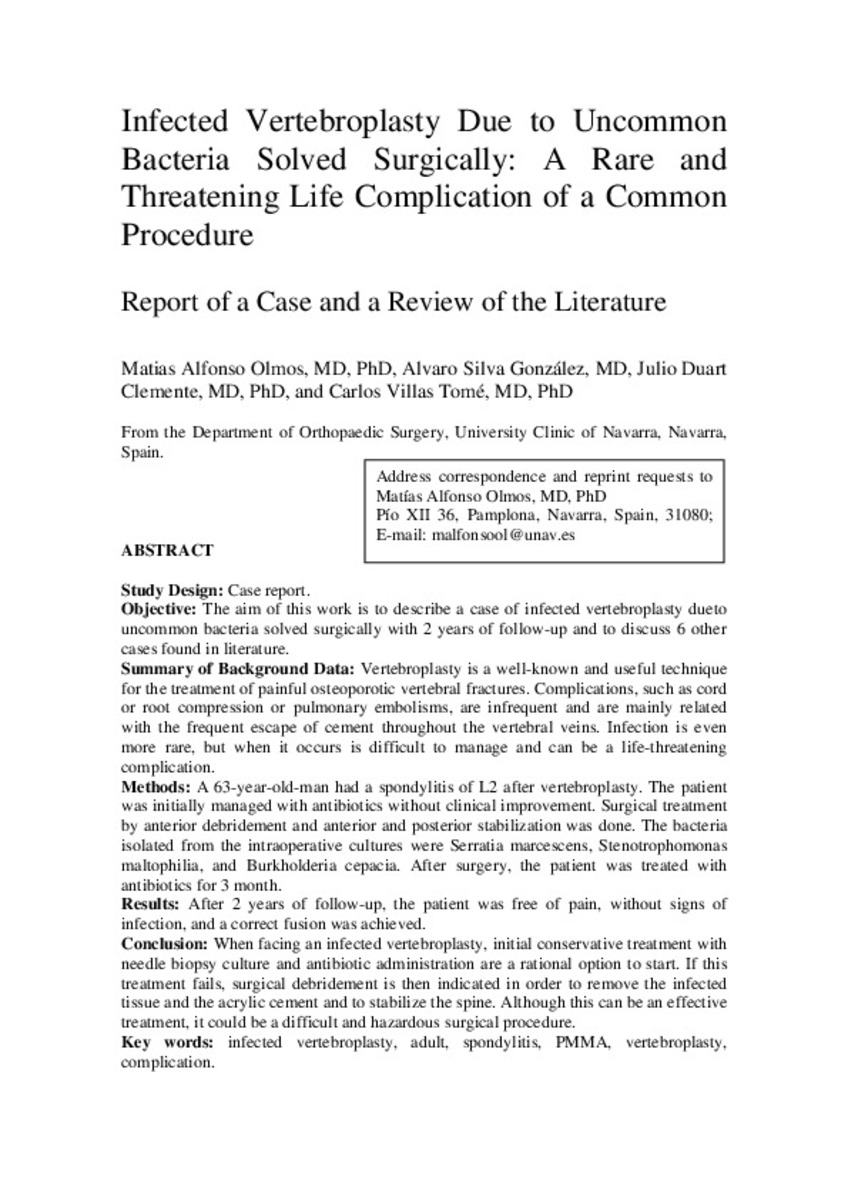Full metadata record
| DC Field | Value | Language |
|---|---|---|
| dc.creator | Alfonso-Olmos-García, M. (Matías) | - |
| dc.creator | Silva, Á. (Álvaro) de | - |
| dc.creator | Duart-Clemente, J. (Julio) | - |
| dc.creator | Villas-Tome, C. (Carlos) | - |
| dc.date.accessioned | 2012-10-16T10:22:48Z | - |
| dc.date.available | 2012-10-16T10:22:48Z | - |
| dc.date.issued | 2006 | - |
| dc.identifier.citation | Alfonso Olmos M, Silva González A, Duart Clemente J, Villas Tomé C. Infected vertebroplasty due to uncommon bacteria solved surgically: a rare and threatening life complication of a common procedure: report of a case and a review of the literature. Spine (Phila Pa 1976). 2006 Sep 15;31(20):E770-3. | es_ES |
| dc.identifier.issn | 1528-1159 | - |
| dc.identifier.uri | https://hdl.handle.net/10171/23395 | - |
| dc.description.abstract | Case report. OBJECTIVE: The aim of this work is to describe a case of infected vertebroplasty due to uncommon bacteria solved surgically with 2 years of follow-up and to discuss 6 other cases found in literature. SUMMARY OF BACKGROUND DATA: Vertebroplasty is a well-known and useful technique for the treatment of painful osteoporotic vertebral fractures. Complications, such as cord or root compression or pulmonary embolisms, are infrequent and are mainly related with the frequent escape of cement throughout the vertebral veins. Infection is even more rare, but when it occurs is difficult to manage and can be a life-threatening complication. METHODS: A 63-year-old-man had a spondylitis of L2 after vertebroplasty. The patient was initially managed with antibiotics without clinical improvement. Surgical treatment by anterior debridement and anterior and posterior stabilization was done. The bacteria isolated from the intraoperative cultures were Serratia marcescens, Stenotrophomonas maltophilia, and Burkholderia cepacia. After surgery, the patient was treated with antibiotics for 3 month. RESULTS: After 2 years of follow-up, the patient was free of pain, without signs of infection, and a correct fusion was achieved. CONCLUSION: When facing an infected vertebroplasty, initial conservative treatment with needle biopsy culture and antibiotic administration are a rational option to start. If this treatment fails, surgical debridement is then indicated in order to remove the infected tissue and the acrylic cement and to stabilize the spine. Although this can be an effective treatment, it could be a difficult and hazardous surgical procedure. | es_ES |
| dc.language.iso | eng | es_ES |
| dc.publisher | Lippincott, Williams & Wilkins | es_ES |
| dc.rights | info:eu-repo/semantics/openAccess | es_ES |
| dc.subject | Lumbar Vertebrae/surgery | es_ES |
| dc.subject | Postoperative Complications/microbiology/surgery | es_ES |
| dc.subject | Spinal Fusion/instrumentation/methods | es_ES |
| dc.title | Infected Vertebroplasty Due to Uncommon Bacteria Solved Surgically: A Rare and Threatening Life Complication of a Common Procedure | es_ES |
| dc.type | info:eu-repo/semantics/article | es_ES |
| dc.type.driver | info:eu-repo/semantics/article | es_ES |
| dc.identifier.doi | http://dx.doi.org/10.1097/01.brs.0000240202.91336.99 | es_ES |
Files in This Item:
Statistics and impact
Items in Dadun are protected by copyright, with all rights reserved, unless otherwise indicated.






